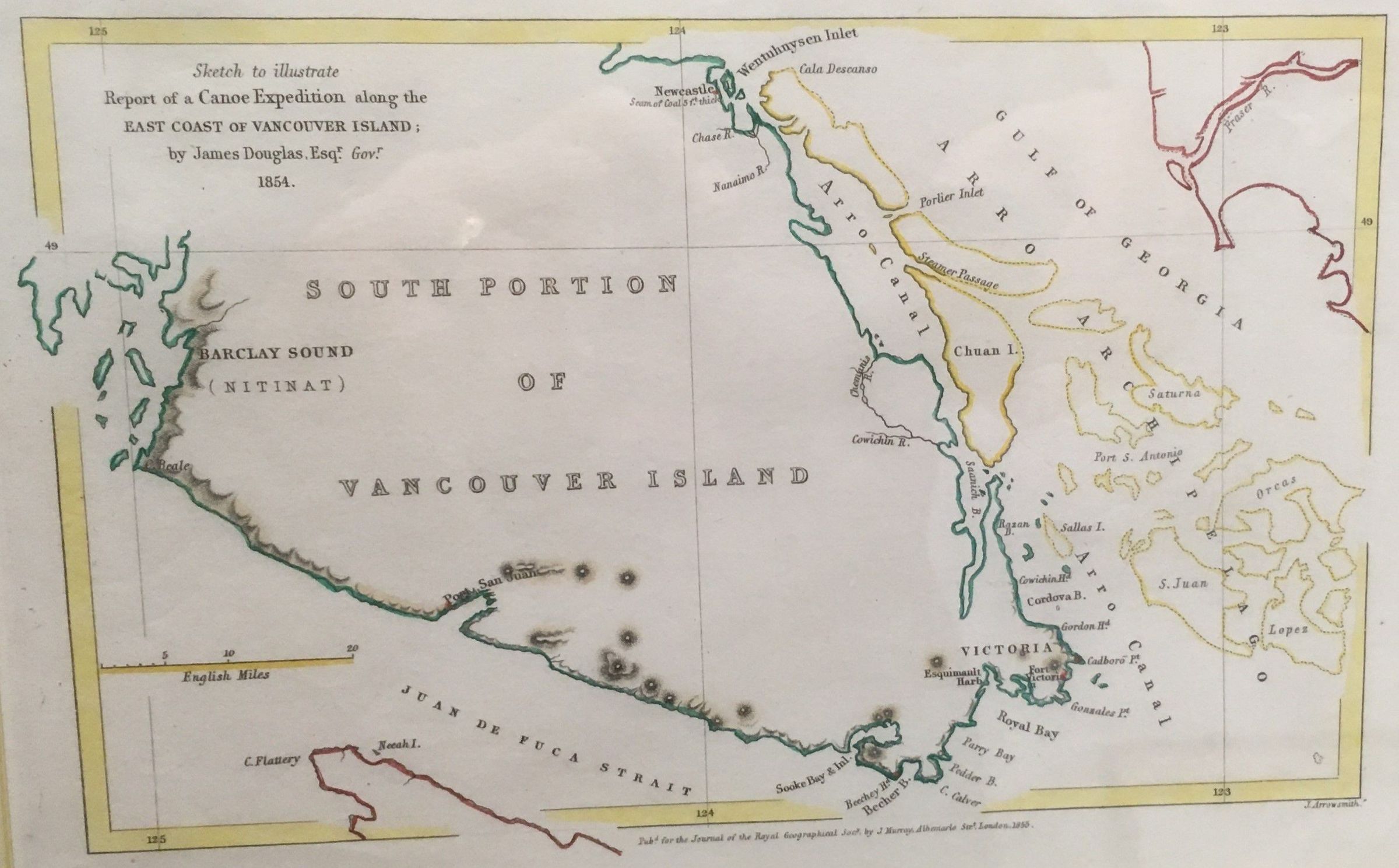Name/Title
Sketch to illustrate Report of a Canoe Expedition along the East Coast of Vancouver IslandEntry/Object ID
2001.02.02Description
Map
This is a hand-coloured engraving by John Arrowsmith published for The Journal of the Royal Geographical Society by John Murray, Albermarle Street, London in 1855 after a sketch done by James Douglas (Governor of the Crown colonies of Vancouver Island and British Columbia, later Sir James Douglas) in 1854 illustrating the "Report of a Canoe Expedition along the East Coast of Vancouver Island, [B.C.]"Context
In The Journal of the Royal Geographical Society of London Vol. 24 (1854/55), pp. 245-249.
From page 245:
"X. - Report of a Canoe Expedition along the East Coast of Vancouver Island. By JAMES DOUGLAS, Esq., Governor. Communicated by the COLONIAL OFFICE. With Note on Queen Charlotte Islands. Read February 28, 1853.
[Original "Despatch to London. 27th Augst 1852 To the Right Honble Sir John S Pakington. Her Majesty's Principal Secretary of State For the Colonial Department. Copy to Admiralty… And 18 Dec/52. 6 minutes to Hudsons Bay Comp 27 Dec/52."]
SIR, Fort Victoria, Aug. 27, 1852.
…I have carried out the project, which I have long entertained, of a canoe expedition through the Canal de Arro, and along the E. coast of Vancouver Island, for the purpose of examining the country, and of communicating with the native tribes who inhabit that part of the colony; and I will now concisely state the result of my observations in the course of that journey...."Publication Details
Illustrator
Sir James Douglas, KCB, RGS (1803-1877), John Arrowsmith (1790–1873)Volume/Number/Issue
Vol. 24Place Published
Region
Western EuropeContinent
EuropeDate Published
1855Place Printed
Region
Western EuropeContinent
EuropeNotes
Original sketch (1854): James Douglas (1803-1877)
Hand-coloured engraving (1855): John Arrowsmith (1790–1873)
The engraved map was inserted in between pp. 248 and 249, not paginated.
_____________________
Engraving is a fine-art intaglio printmaking process, derived from goldsmith engraving techniques dating from work by Northern Renaissance German printers during the first half of the 15th century. Engraving involves the incision of a design onto a metal surface (usually copper), by making grooves using a burin, a steel tool with a square or diamond-shaped head. This produces a high quality line with a clean edge. Other tools - like mezzotint rockers, roulets and burnishers - can be used to create additional textured effects.
Up until the mid-19th century, engraving achieved widespread popularity as a means of replicating fine art images on paper, as well as illustrations for books and magazines. Since then it has been mostly replaced by etching and other techniques.Inscription/Signature/Marks
Type
InscriptionLocation
In print upper left: Sketch to illustrate Report of a Canoe Expedition along the EAST COAST OF VANCOUVER ISLAND by James Douglas Esqr. Govr. 1854
Lower centre: Pubd. for the Journal of the Royal Geographical Socy. by J. Murray, Albermarle Strt , London, 1855
Lower right: J. Arrowsmith [engraver]Dimensions
Dimension Description
Visible imageHeight
12.7 cmWidth
20.3 cmAcquisition
Acquisition Method
Legacy collection - detail unknown


